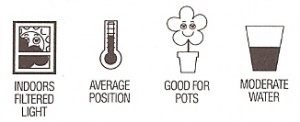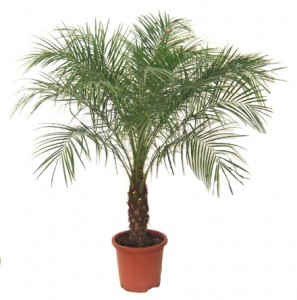Common Names:
Dwarf Date Palm or Pygmy Date Palm, Miniature Date Palm
Distribution & Habitat:
Rainforest of Laos/Vietnam/Thailand.
Description:
Phoenix roebelenii is small to medium sized palm to about 3m, although older plants can be quite tall. It has a thick crown of narrow, arching, dark green fronds, which are much finer than those of the other types and have a thin layer of white scales. The short, slender stem eventually becomes roughened as old leaf bases accumulate along its length. Although the plant normally has only a single stem, it sometimes produces several.
To maintain single-crowned plants which tend to look better as pot specimens, remove any surplus stems while they are still young. Phoenix roebelenii rarely grows taller than a metre, but it may achieve a spread of more than a metre, with 90 cm long fronds.
Cream colour flowers are held on short, 30 cm inflorescences and are followed by small black dates on the female plants (male flowers are borne on a separate plant). Although this palm is single stemmed most nurseries offer it in containers planted with 3 to 5 specimens. When grouped like this, the stems tend to curve gracefully away from the centre of the clump creating an especially attractive arrangement.
Proper Care:

Light: Phoenix roehelenii does best when kept in filtered light, but will also thrive in full sunlight.
Temperature: All these palms grow well in normally warm room temperatures, but they do best if they are encouraged to have a winter rest period at about 10-13C.
Watering: Water sparingly, making the mixture barely moist during the rest period. When active growth begins, increase amounts of water gradually; and water plentifully during the active growth period, giving enough to keep the mixture thoroughly moist. Never allow pots to stand in water, however. As winter approaches, begin to reduce amounts gradually once more.
Feeding: Apply standard liquid fertilizer to established plants once every two weeks during the active growth period only.
Potting and repotting: Use a soil based potting mixture. Repot these palms in pots 5 cm larger every two or three years just as new growth starts in spring. One sign that a plant needs a bigger pot is the appearance of many fine roots on the surface of the potting mixture. In repotting, it is essential to pack the mixture down firmly, but be careful not to damage the thicker roots. Pots from 25-30 cm are big enough for a metre or so tall specimen; small tubs should be used for larger ones. Leave enough space between the mixture surface and the rim of the pot to take plenty of water.
Once the maximum container size has been reached, an annual top-dressing with a few centimetres of fresh potting mixture will suffice.
Propagation: Commercially, phoenix palms are raised from seed. This is a slow process (they take about 3 months to germinate), however, and is not recommended for amateur growers. Some gardeners plant date stones. The stones germinate easily in spring if they are placed in a warm position and kept moist, but the first leaf is a single undivided section, and it may take two or three years for leaves with divisions to appear.
Set the stones individually in 8 cm pots or start those in seed boxes. In the latter case, pot in 8 cm pots after they have germinated and have made about 5-8 cm of growth. Thereafter their cultivation needs will be those of mature phoenix palms.
If sucker shoots at the base of Phoenix roebelenii are carefully detached, they should have some roots already formed, and such shoots can be used for propagation. Pot each shoot in an 8 cm pot of the standard potting mixture, place it in bright filtered light, and water it sparingly-just enough to keep the mixture barely moist. After new top growth indicates that the shoot is well rooted, treat the young plant in the same way as a mature phoenix palm.
Usage
Pygmy date palm excels in containers of all kinds. Also looks great by patios and entry ways. Use clumps of these palms as specimens and to serve as focal point in a mass planting of annuals. Also nice combined with evergreen shrubs in a mixed hedge. This rugged little palm looks great indoors - just give it a bright spot and keep it out of drafts (and away from where someone could brush against the spines - see Warning).
Phoenix roebelenii is said to remove formaldehyde and xylene (a chemical found in plastics and solvents) from the air.
WARNING
Many palms are armed with dangerous spines and other sharp edges. But we are most likely to come in painful contact with those of smaller stature like the pygmy date palm. This palm has sharp needle-like spines arranged near the base of the leaf stem. These can easily penetrate skin, tissue - sometimes even protective clothing. This often results in painful infections and possibly other, direr complications. Keep this plant away from children's play areas and walkways. Use caution and sturdy protective clothing when gardening near this and similar palms.
Summary:
Phoenix
These plants require some special conditions and are unlikely to thrive without them.
CHARACTERISTICS:
Foliage - green
Shape - bushy
PROPER CARE:
Watering in rest period - sparingly
Watering in active growth period - plentifully
Light - bright filtered
Temperature in rest period - min 7C max 16C
Temperature in active growth period - min 16C max 24C
Humidity - low



